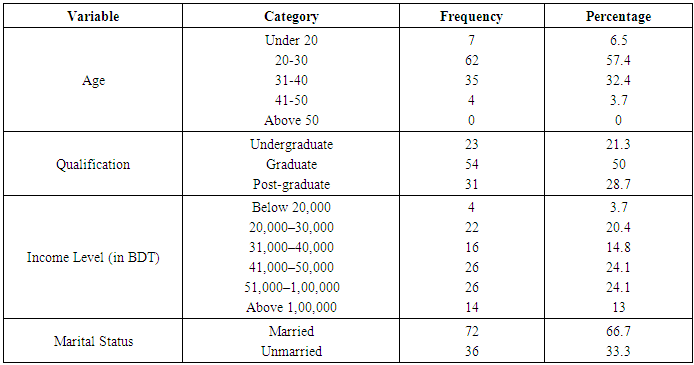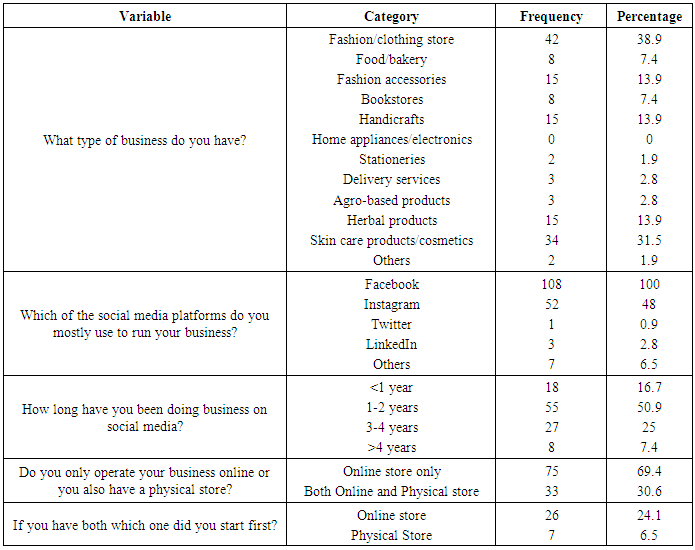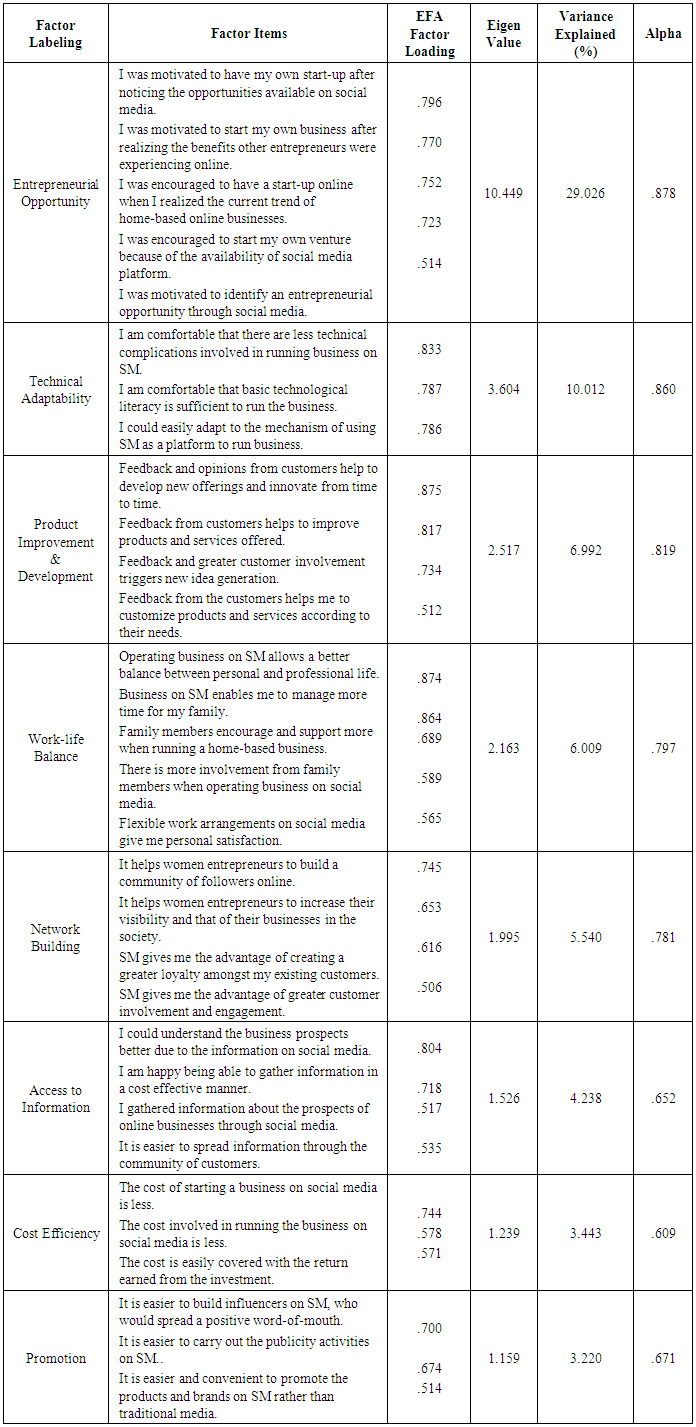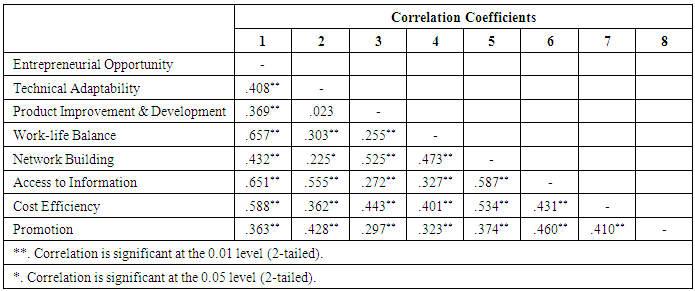-
Paper Information
- Previous Paper
- Paper Submission
-
Journal Information
- About This Journal
- Editorial Board
- Current Issue
- Archive
- Author Guidelines
- Contact Us
Management
p-ISSN: 2162-9374 e-ISSN: 2162-8416
2018; 8(4): 99-108
doi:10.5923/j.mm.20180804.02

Social Media and the Creation of Entrepreneurial Opportunity for Women
Madhobi Hossain, Mayeesha Fairuz Rahman
School of Business Studies, Southeast University, Bangladesh
Correspondence to: Madhobi Hossain, School of Business Studies, Southeast University, Bangladesh.
| Email: |  |
Copyright © 2018 The Author(s). Published by Scientific & Academic Publishing.
This work is licensed under the Creative Commons Attribution International License (CC BY).
http://creativecommons.org/licenses/by/4.0/

A noteworthy growth in the number of women entrepreneurs operating on social media platforms in Bangladesh has been observed in the recent years. This is indisputably considered a significant contribution to the economy of the country as women comprises of half the entire population. Hence, this study aims to investigate the factors that have influenced women to take up their businesses to social media, and how these in return have opened doors of entrepreneurial opportunity for them. Factor Analysis was carried out using SPSS, on the data collected from 108 respondents, which eventually resulted in the extraction of 8 factors, including, entrepreneurial opportunity, technical adaptability, work-life balance, product improvement and development, network-building, access to information, cost efficiency, and promotions. The study further tested the correlation between the variables identified, followed by a regression analysis to find the relationship between social media and entrepreneurial opportunity for women entrepreneurs in the urban areas of Bangladesh. It is important to note from the findings that the benefits of running a business on social media have definitely contributed to women entrepreneurship. However, two factors: product improvement and development, and promotion, do not have a significant relationship with entrepreneurial opportunity.
Keywords: Women entrepreneurs, Social media, and entrepreneurial opportunity
Cite this paper: Madhobi Hossain, Mayeesha Fairuz Rahman, Social Media and the Creation of Entrepreneurial Opportunity for Women, Management, Vol. 8 No. 4, 2018, pp. 99-108. doi: 10.5923/j.mm.20180804.02.
Article Outline
1. Introduction
- Women constitute of almost half the total population of Bangladesh (Trading Economics, 2016; Countrymeters, 2018). Although, in accordance with the reports of Bangladesh Bureau of Statistics (BBS), there has been a significant percentage increase in the female labour force by 4.6% (Islam, 2018), the unemployment rate among female graduates is still 2.5 times higher than their male counterparts (Parvez, 2018). This implies that a major portion of the human resource is underutilized, obstructing the socioeconomic growth of the country (Ahammad & Moudud-Ul-Huq, 2013). Due to the insufficient employment opportunities for women (Afroze et al., 2014), development of women entrepreneurship in Bangladesh has become indispensable. As defined by Gartner et al. (2004) entrepreneur is one who commences a commercial enterprise, whereas Shumpeter, 1934 (cited by Afroze et al., 2014), defined an entrepreneur as someone “who introduces something new to the economy”. In addition, UNDP in its Human Development Report (cited by Ahammad & Moudud-Ul-Huq, 2013) defines women entrepreneur as a woman who has solely or with partners started a business, and willing to undertake risk, responsibilities, and managerial activities of the organization. It is undeniable that entrepreneurship plays a crucial role in sustainable development and poverty reduction through the creation of job opportunities, and providing support for lesser-privileged groups like youth and women (UNDP, 2014). The contribution of the women workforce to the GDP growth of Bangladesh is 34%, and it is being estimated that a 10% rise in their participation would upsurge the growth by 1% (Dhaka Tribune, 2017). Hence, it is apparent that women entrepreneurship has become a pivotal driving force to the economic growth and social development of the country. Women now understand the gravity of entrepreneurship, which is evidently reflected in the rise of the number of women entrepreneurs, constituting about 10% of the total entrepreneurs in Bangladesh (Chowdhury, 2017). While women entrepreneurs in the rural areas are empowering themselves through self-employment in the agricultural and non-agricultural businesses, others in the urban areas, are exploring sectors such as handicrafts, fashion house, food, parlour and ICT (Ahammad & Moudud-Ul-Huq, 2013). Another shift in business can be noticed in the form of e-commerce, which is defined as the process of transacting via computer networks and the Internet (Turban, et al., 2008). However, in the recent years, more businesses are having their operations on the social network sites (or social media). According to the E-Commerce Association of Bangladesh (e-CAB), the trade body for e-commerce in Bangladesh, there are about 700 e-commerce sites (Export.gov, 2017) and over 10,000 Facebook-operated e-commerce businesses today (Farhin, 2018). Although there are no available data on the number of online women entrepreneurs in Bangladesh, their presence in this particular platform is remarkable. Social media is regarded as a major strategic tool that provides different tactics for women entrepreneurs to advertise, market and attract clients, which eventually results in transactions (Melissa et al., 2013; Upkere et al., 2014). This has created opportunity for small-scale women entrepreneurs who find it challenging to establish themselves on traditional media, due to the various economic and social hurdles they encounter (Genç & Oksüz, 2015), such as lack of finance, lack of family support, lack of managerial experience, inadequate training, illiteracy, and gender discrimination (Afroze et al., 2014). Because of the beneficial aspects of social media, including flexibility and low-cost investment (Cesaroni et al., 2017), there is a strong argument for it being considered as an income creation method (Tosifyan & Tosifyan, 2017).The paper therefore aims to identify the factors that influence women in the urban areas of Bangladesh to operate businesses on social media sites, and explicate the extent to which these factors encourage them to identify entrepreneurial opportunities. This study is carried out with the expectation that it will contribute academically and practically to the better understanding of what opportunities prevail for female entrepreneurs if they choose to start or operate their existing businesses through social media. Moreover, some pitfalls of depending on social media have also been highlighted, which could enable the potential women entrepreneurs to analyze all the positive and negative aspects when deciding to use the social media platforms to run businesses.
2. Literature Review
2.1. Women Entrepreneurship in Bangladesh
- With half the population being women, it is substantially perceptible that if such a significant share of human resources is not effectively deployed, the opportunity for a sustainable livelihood in a developing country will cease to exist. If more women in Bangladesh take up the challenge of self-employment, experts strongly believe that poverty and gender discrimination will be eradicated (Parvin et al., 2012; UNDP, 2014). Usually, women are more victimized due to illiteracy, unawareness, inflexible social customs and religious constraints (Chowdhury, 2000; Tambunan, 2009). A number of researchers exploring this subject came up with the common problems and challenges faced by women entrepreneurs in Bangladesh, which includes lack of capital, training, knowledge and family support; difficult access to marketing facilities; insufficient knowledge about technology; gender discrimination; and social, cultural and religious barriers (Ahammad & Moudud-Ul-Huq, 2013; Zaman, 2013; Afroze et al., 2014; Islam & Ahmed, 2016). Conversely, women today are different from the women of past years, as they now seek social and economic independence (Rinkal et al., 2004), and this aspiration in return is working as a motivator towards entrepreneurship (Mitchell, 2004). In a country predominated by gender and class biases (WED Paper, 2001), it is commendable to find women break through the clutters of socioeconomic barriers and venturing into entrepreneurship both in the urban and rural areas (Chowdhury, 2017). Earlier, most of the entrepreneurial initiatives were focused in the urban areas (Karim, 2017), but now a new class of women entrepreneurs has emerged in the rural areas as well (Parvin et al., 2012). According to the report published by SME Foundation (2009), the largest number of women entrepreneurs (27.8%) were engaged in designing personal wears; and the second largest share (12.9%) in knitwear and ready-made garments, followed by 10.8% ownership in agro-processing and agribusiness. 46.8% of the women entrepreneurs were involved in various other trades including handicraft manufacturing, tailoring, embroidery, catering services, food, confectionery, beauty parlours, fitness centers, printing and publishing. Presence of women entrepreneurs were also found in cosmetics, pharmaceuticals, diagnostic centers, education services, electronics, and leather-making goods. However, the report published by the SME Foundation (2009) did not take into account women entrepreneurs’ presence on social media or any e-commerce business, perhaps because the use of social media has gained prominence in the very recent years. Entrepreneurial opportunity for women has not only empowered them in the society, but they are also making a significant contribution to the economy by supporting their families with their earnings (Parvin et al., 2012). Referring back to the SME Foundation report (2009), 10.2% of the women bore the family and household expenditure, and 2.2% managed their personal expense without inconveniencing the family. Some other contributions included bearing the expense of children’s education, managing financial issues in the business, creating employment for family members, and supporting the poor. It has been observed that the majority of the female enterprises are small scale than the male-oriented ones (Daniel, 2003) and mostly run home-based businesses (Cesaroni et al., 2017), which implies that there are still a lot of challenges that limits the full utilization of these women’s potentials. In an attempt to encourage more of such women entrepreneurs, several public and private institutions are offering support such as Bangladesh Small & Cottage Industries Corporation (BSCIC); Women Entrepreneurship Development Program (WEDP); Bangladesh Rural Development Board (BRDB); Micro-Industries Development Assistance & Services (MIDAS); Bangladesh Rural Advancement Committee (BRAC); Bangladesh Women Chamber of Commerce & Industry (BWCCI); and Bangladesh Association of Women in SME (BAWSME) (Chowdhury, 2017; Karim, 2017). Moreover, the Government, in its National Action Plan (NAP) includes strategies for the development of women entrepreneurship that consists of establishing Women Entrepreneurship Development Cell, publishing a directory of women entrepreneurs, ensuring easy access to markets, and many more (Chowdhury, 2017).
2.2. Social Media for Entrepreneurs
- Over the decades, numerous trends have been experienced in the business environment and got withered in no time at all. Occasionally, the arrival of some phenomena hold the power to change and influence the business environment to a great extent; one such phenomenon is social media, which is often interchangeably used with the term Web 2.0 (Kadam & Ayarekar, 2014). There are varieties of social media platforms ranging from social networks, private social networks, to blogs and micro-blogs (Shabbir et al., 2016). Some of the popular and widely used social networking sites include: Facebook, LinkedIn, Instagram, Twitter, Skype, WatsApp, Viber, WordPress, YouTube, Flikr, Google+, Pinterest, Quora, Reddit and Snapchat (Bajaj, 2017; Mehra, 2017; Maina, 2018). Despite its inception in 1997 (Shabbir et al., 2016), there was a boom in social media in the year 2000, when a major increase was seen in the number of social networking sites (Kadam & Ayarekar, 2014). As a result, the way customers and entrepreneurs communicate transformed because this platform allowed businesses to have greater access to a wider range of target audiences; comprehend their varying needs and wants; improve and innovate products and services; and encourage customer engagement with the business (Smith and Taylor, 2004; Jagongo & Kinyua, 2013). However, amongst all the social media sites, the most widely used social media platform by businesses and marketers is Facebook (Sachs, 2016; Slabbert, 2018; Driver, 2018). According to the reports of Statista (2018), the leading social media platforms for marketers all over the world include Facebook (94%), Instagram (66%), Twitter (62%), LinkedIn (56%), YouTube (50%), Pinterest (27%) and Snapchat (8%). Similarly, in Bangladesh, the majority of the online retailers run through Facebook (Gilchrist, 2018). Due to the various advantages of doing business on social media, it has reshaped the conventional marketing methods in the country. Now many, starting from students to housewives can commence a start-up on social media, since it does not require a physical space or huge manpower (Farhin, 2018). As stated by Fruhling and Digman (2000), social media can upsurge the customer base and market share, which in turn can facilitate the growth strategies of a business. Logically, a two-way communication between the customers and the business can provide information and ideas, to enhance the quality of the business’s market offerings and also to encourage them to innovate. The platform can, therefore, provide opportunities to attract potential customers and retain existing ones, building a stronger relationship between the parties involved (Mangold & Faulds, 2009). Social media can help provide “marketing that is more effective, new communication and distribution channels, shorter time to market, customized products, 24-hour online technical support, and online interactive community” (Mukolwe & Korir, 2016, p.249). The reason businesses are taking full advantage of the social networking sites is because there is a new generation of consumers whose buying behaviour is very different from the previous groups of customers. This emergence of an entirely new economy on the Internet is the outcome of consumers seeking more convenience in shopping, better communication, more engagement and power to decide (Tigo, 2012; Perju, 2015; Tosifyan & Tosifyan, 2017). Entrepreneurs consider social media a useful tool because it encourages identification of opportunities in the business environment (Park & Sung, 2017). There are varying views about “entrepreneurial opportunity”; where Schumpeter (1932) stated that one must look for new information available in the market in order to create an opportunity, Kirzner (1997) on the other hand argued that a business must use the existing information to discover an opportunity. Social media is such a platform that has now enabled entrepreneurs to discover and create opportunities by assessing both existing and new information by communicating and interacting with peers on the network (Park & Sung, 2017).
2.3. Social Media and Development of Women Entrepreneurship in Bangladesh
- Arrival of social media has undoubtedly opened up windows of new opportunities for women (Mukolwe & Korir, 2016). A new breed of online women entrepreneurs has surfaced who are not only encouraging new startups on social media, but are also using the platform to enhance the existing businesses and create networks of customers like never before (Fischer & Reuber, 2011). In Bangladesh, amidst the wide array of e-commerce pages on Facebook, the majority of the owners are women, according to the findings of the daily newspaper, The Dhaka Tribune (Farhin, 2018). There is no adequate information, on how many women are registering their businesses on social media annually, or how are their businesses performing. However, many researchers exploring the field of women entrepreneurship, disclose that social media has made new ways of doing business and networking possible for women (Genç and Oksüz, 2015; Cesaroni et al., 2017; Mukolwe & Korir, 2016; Upkere et al., 2014; Melissa et al., 2013; Oke, 2013). Some of the mutual benefits have been extracted from the findings of researches conducted on the relationship between social media and women entrepreneurs in the developing countries (Melissa et at., 2013; Upkere et al., 2014; Vivakaran & Maraimalai, 2016; Cesaroni et al., 2017), which are mentioned as follows: Ÿ Social media has allowed women to recognize entrepreneurial opportunity through selling online and realize that their idle time can be used productively to earn profit.Ÿ There is low investment and operating costs involved in a social media start-up that eventually motivates women entrepreneurs.Ÿ Since, many women can run their businesses from home and at their own convenience, this has helped them to have a better work-life balance, where they can effectively manage both their professional and personal lives simultaneously.Ÿ The new source of earning has provided the women with greater financial resources and thus autonomy.Ÿ Women entrepreneurs have been able to make contributions to the family income, which eventually empowered them to participate in decision-making.Ÿ It is an advantage that in the majority of the businesses on social media, the women do not require high level of technological literacy, which reduces the start-up complication.Ÿ Some other benefits common for all genders include cost effective promotion; access to a wider target audience; product development and enhancement; establishment of external communities of customer who would share their experiences; and the scope of better educating customers (Baghdadi, 2013; Brengman & Karimov, 2012; Cesaroni et al., 2017).In contrast to the advantages discussed, a qualitative research conducted by Genç and Oksüz (2015) revealed some difficulties women entrepreneurs face while doing business on social media. Some of the major problems identified were: imitation of work, professional dissatisfaction, difficulty in identifying specific target audience, wider spread-out of market share, and unfair competition. Although a few authors have explored the influence of social media on women entrepreneurs in the context of developing countries (Cesaroni et al., 2017), there is very little academic evidence on how social media have accelerated women entrepreneurship, particularly in Bangladesh. Numerous literature has been extracted in relevance to women entrepreneurs (Afroze et al, 2014; Ahammad & Moudul-Ul-Huq, 2013; Islam & Ahmed, 2016), but none of those indicated the impact social media has on them, or the extent to which it has contributed to the growth of potential female entrepreneurs in Bangladesh today. The various literatures covered on the specific subject form the foundation of this particular research paper. All the advantages and challenges identified so far have been used to design the research framework and instrument, so that the influence of social media usage on women entrepreneurship development can be analyzed, in context of Bangladesh.
3. Research Methodology
- The study attempts to explore what factors may influence the use of social media by women entrepreneurs as their primary business platform, and whether these have an influence on creating entrepreneurial opportunity for them in return. Hence, to conduct the research, a five-point Likert-scale questionnaire was developed with the help of secondary data gathered from previous literature. The scale ranges from point “5”, representing “Strongly Agree”, to point “1”, which signifies “Strongly Disagree”. A combination of both convenience sampling and random sampling were adopted to gather primary data. As part of the convenience sampling, self-administered survey by means of Google Forms were submitted to the Facebook pages that were known to the researchers already, and the rest of the forms were distributed randomly to various online businesses. Since, it was not clear from the Facebook pages if the online store belonged to a woman, a prior message was given, requesting only women entrepreneurs to fill-in the survey. From a total of 325 distributed questionnaires, only 136 were returned, and 108 finalized, due to the discarding of extreme responses and incomplete data. The questionnaire had three sections with the first focusing on the background information of the respondents (i.e. women entrepreneurs running business operations on social media). The second part included 35 questions that were designed to gather information on the factors influencing women to take up their businesses on social media (i.e. independent variables), as well as their perception and behaviour towards entrepreneurship as a result (i.e. dependent variables). The final part only had one question that aimed to explore the problems encountered by women entrepreneurs when operating on social media. An Exploratory Factor Analysis (EFA) was carried out using the Statistical Package Software for Social Sciences (SPSS.24), followed by reliability test and KMO-Bartlett test. A further Multiple Regression Analysis was done, after the factors were extracted from EFA to assess the relationship between social media and women entrepreneurship in Bangladesh. In support of the above-mentioned methods, Frequency analysis was found useful to identify the profile of the respondents and explore the challenges faced by them.
4. Data Analysis
- Table 1 illustrates the demographic profile of the respondents, which exhibits that majority of the respondents, i.e. 62% fall into the age group of 20-30. Most of the women entrepreneurs surveyed are graduates accounting for 62%, while 23% are found to be post-graduates and have a monthly income level between BDT 41,000- BDT 100,000. Interestingly, 72% of them are married, which signifies that operating online allows these successful women to continue working besides their daily household chores, and gives them an opportunity to earn a decent amount of money.
|
|
|
|
|
|
5. Conclusions
- This study has identified that almost all the exploratory variables, namely Technical Adaptability, Work-life Balance, Network Building, Access to information, and Cost Efficiency have significant influence on the dependent variable i.e. Entrepreneurial Opportunity. However, two of the factors, which are Product Improvement & Development and Promotion, are found to have no significant relationship with the dependent variable. One limitation of this study would be the sample size as more accurate data could be congregated, if a greater number of respondents were reached out to. Also, more independent variables could be included which could have an influence on the entrepreneurial opportunity. While doing the study, it has been found that there is no standard performance indicator of these businesses that are being operated online through social media, which means that it is difficult to assess how these female entrepreneurs are exactly performing. Hence, further research could be done in order to evaluate their performances. Furthermore, a comparative study can also be performed by comparing and contrasting the business operations of traditional brick and mortars with the businesses done online through social media, which can further help the potential and existing female entrepreneurs to decide on their mode of doing business.
 Abstract
Abstract Reference
Reference Full-Text PDF
Full-Text PDF Full-text HTML
Full-text HTML




